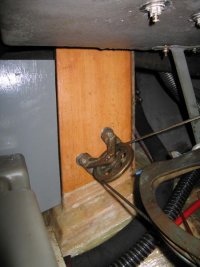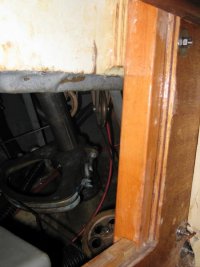We had that problem with our steering on our 32-2. The steel support for the steering that was glassed to the hull broke free on the port side during some particularly challenging off-wind racing on our way to puerto vallarta. Thereafter, whenever we put it through stress, you could hear and feel the 'clunk' as it lifted away from the hull and then bounced back down.
Before we could repair that, we had our s/s cable break -- again, this happened in a race under spinnaker in 25 knots at 2 am. NOT a good time for that to happen. The new s/s cables and chain were a piece of cake to replace compared to the support structure.
We thought about replacing it, but it is in the basic support structure ... which is not something normally replaced. It seems to be a custom build.
We fixed it though, instead of replacing it, and it works great.
First, the area around the anchor point was cleaned real well, with a wire brush, vacuum and solvent (Don't remember what kind but it was something from west marine)
Second, we used Marine Tex to form a dam. Around the outer edges and in the gap between the two anchor points.
Third, we took West System epoxy, mixing it in batches, and pouring it into the resevoir formed by the Marine Tex dams. We layered the WS in over several days. What resulted is the anchor points are now epoxied in with about 3/4 of an inch of cover. It is as firm a hold as it has ever been.
Hope this helps.
Jim McCone
Voice of Reason E-32-2 Hull #134
Redondo Beach, CA


